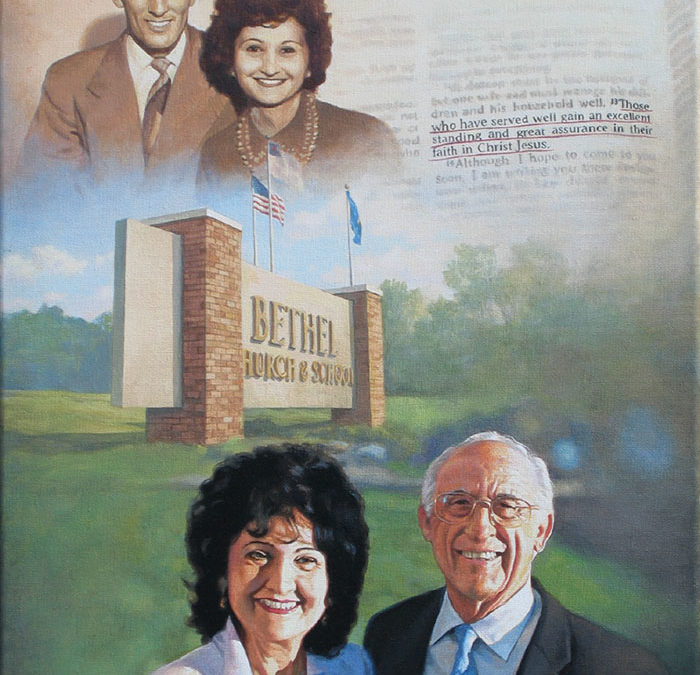
by Matt Philleo | Apr 15, 2017 | Christianity & Culture, Encouraging Thoughts, How to Paint Instruction, My Art in Progress, Personal Inspiring Stories, Tips for Artists
It’s easy to get frustrated in the middle of painting an acrylic portrait. Possibly your skin tones aren’t looking natural, or the values are off. Maybe the portrait just doesn’t look like the person you’re trying to capture. When you’re going for realism, and it just isn’t happening, what do you do?
Although you may be tempted to give up, don’t.
I want to give you 3 reasons why:
1. You will save time, paint and materials.
Let’s face it. Painting is a labor of love. As artists, we could choose more lucrative jobs, where our exchange of time for money paid better. But we put a lot of hours into creating a high-quality unique work of art.
So if you have put several hours into a painting only to scrap it and start over, you lost that time. In addition, you lost money with the cost of canvas, paint, and wear and tear on your brushes.
Now, even if you paint just as a hobby, it’s frustrating to take the time to create something and then have nothing to show for that time you allotted in your busy schedule. Finishing the painting makes sense then, even from a purely material standpoint.
2. Pushing past a difficult point in your painting will build your resilience and grow your “artistic muscle”.
It’s easy to give up. Sticking with something when your thoughts and emotions are screaming, “This looks terrible…I’m done with this!” is way, way harder.
This is similar to weightlifting. Serious bodybuilders know they won’t get great results unless they push past the pain. As they break down their muscle tissue, they also break down barriers and limitations they previously had. With that, their muscles grow larger and stronger, because muscles don’t like to be in pain. Endurance and stamina increases.
Several years ago, I created a portrait to celebrate my pastor’s 80th birthday. It was a portrait of him and his wife, a 16 x 20 acrylic on canvas. During a certain point in the painting, it looked pretty bad. My wife came upstairs (where my art studio used to be) and peered in to see how I was doing. She said, “That just doesn’t look right. I don’t know if you can pull it off.”
Umm…thanks!
I thought for a moment, “Can I pull this off?” Well, God helped me to “pull it off” many times. He wasn’t about to quit now. I ignored the doubt and kept at it.
I figured I had a photo that shows me what it should look like. I had a roadmap, a blueprint to tell me how to get there, how to build. And even if I took a scenic detour for a bit, I’d get it where it needed to be, eventually.
A painting is never ruined. It’s just that it might take longer to fix than you would like!
3. You will learn ways of resolving issues in your painting that you can use in future paintings.
In the case of this particular portrait, I learned that even though mid-stage during the painting process, the likeness of the subject may be off, I can correct the facial features with additional layers and it will start to look like the person.
Here is the portrait in the beginning stages. Early on, there is a lot of excitement in creating a painting. I had great expectations for how it would turn out, and I cut myself a lot of slack, because I knew I just started it.
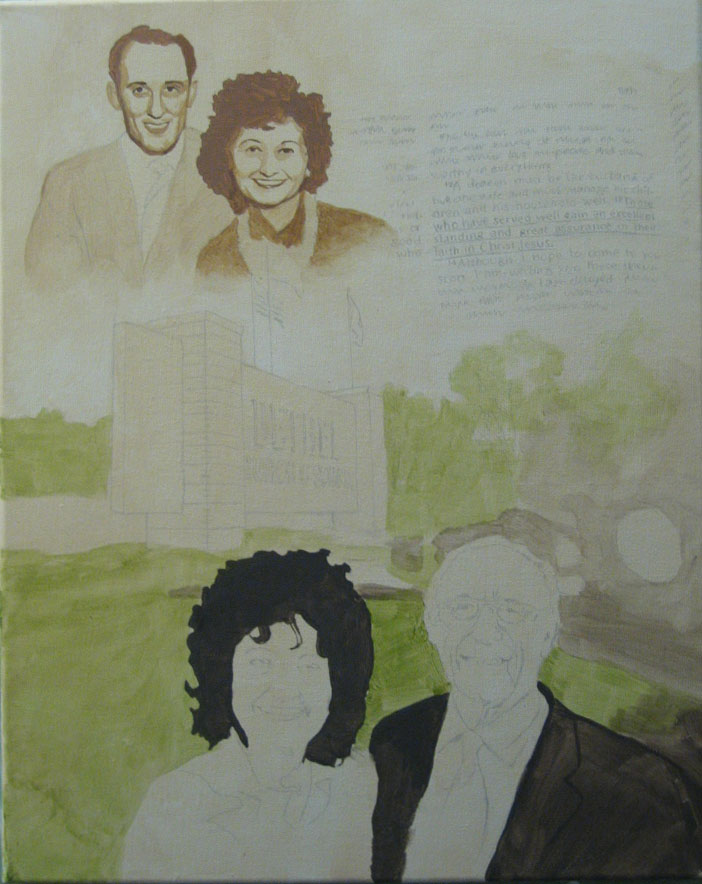
Portrait of Pastor & Mrs. Philip Palser, 16 x 20, acrylic on canvas, 2005 by fine artist Matt Philleo, Step 1
But then as I invest more time into it, I expect that a painting should start “behaving” and looking pretty good, for all the time I put into it. However, that doesn’t always happen. In fact, for me, it usually doesn’t.
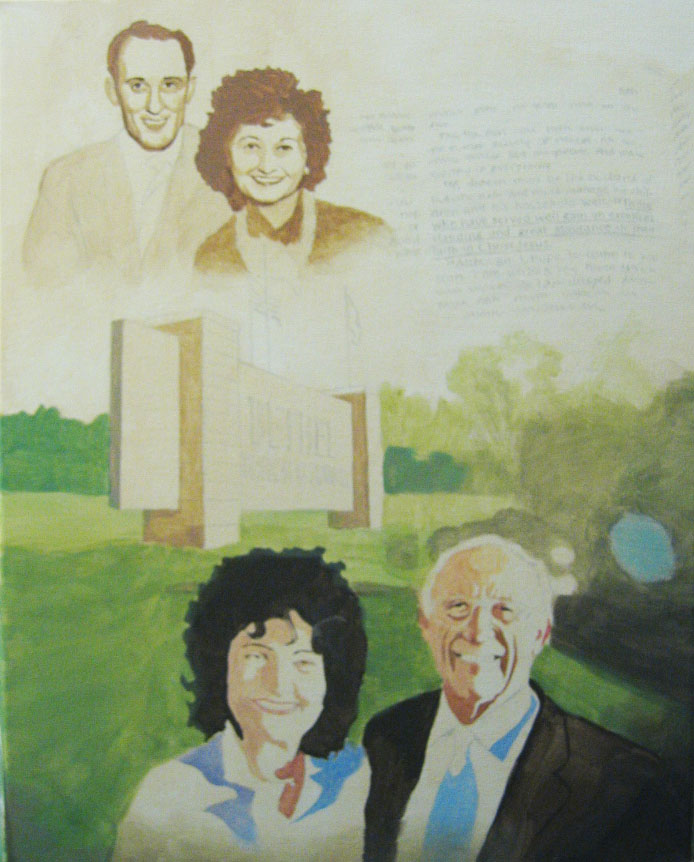
Portrait of Pastor & Mrs. Philip Palser, 16 x 20, acrylic on canvas, 2005 by fine artist Matt Philleo, Step 2
Somewhere around these two stages. the painting looked pretty goofy, and it’s about at this point where my wife remarked, “I don’t know if you can pull this one off.” She said that the pastor’s wife looked like some weird “california girl.”
Even though I was tempted for a moment to give up, I thought something along the lines of, “I know what this needs to look like in the end. I’ve got my reference photo next to me. I’ve got some paint and a palette. Sooner or later, it’s going to look like it should and it will turn out alright.”
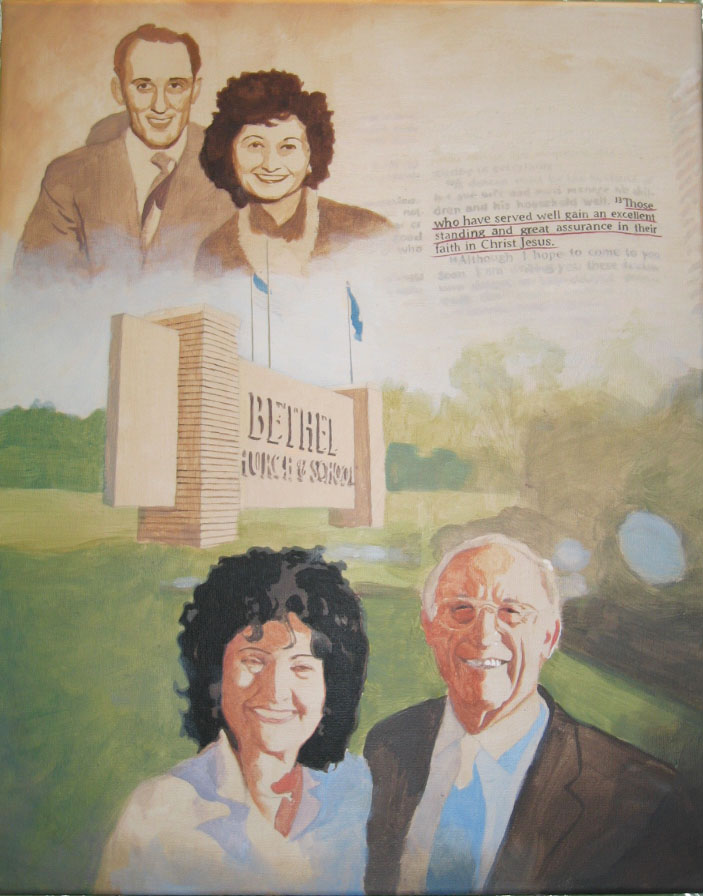
Portrait of Pastor & Mrs. Philip Palser, 16 x 20, acrylic on canvas, 2005 by fine artist Matt Philleo, Step 3
After a few more hours, the painting started to turn the corner. Even though I think I had painted certain areas of the faces a bit too dark, I was able to layer over them with just the right mix of colors to adjust what was off.
When you are establishing values and colors on your faces, sometimes the accuracy you had in your sketch will be thrown off. Capturing these shadows are vital to making a person’s face look like the person you are trying to capture. Since shadows describe the contours and shapes of eyebrow ridges, noses, cheekbones, jawlines, and so many other parts on a human face, it’s important to realize that during the in-between stages, you won’t have an accurate likeness. It’s like a sculptor who has to chisel off many fragments of marble or wood to get the beautiful sculpture that was hiding inside the whole time.
Soon enough, I could see the likenesses taking shape.
That excitement of certain areas of the picture starting to look great then compels you to work even harder to get to the finish line of a signed portrait.
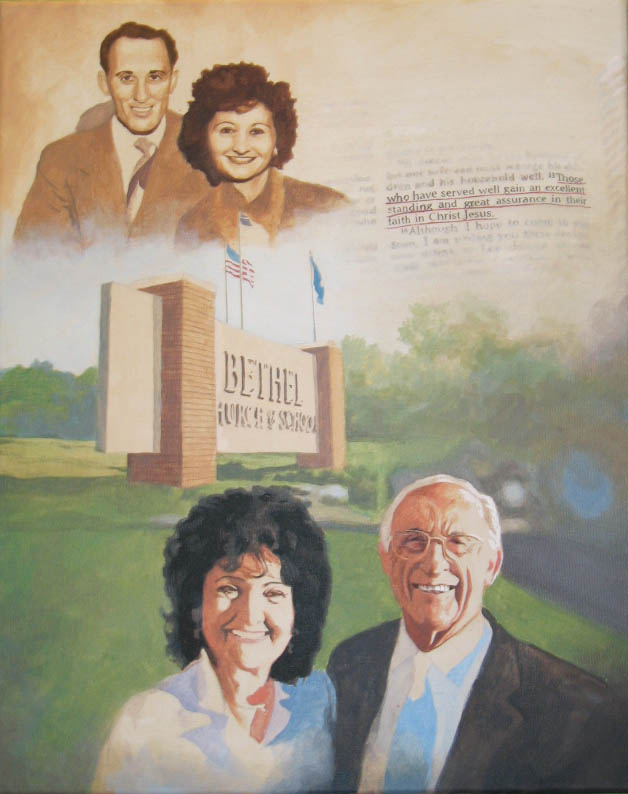
Portrait of Pastor & Mrs. Philip Palser, 16 x 20, acrylic on canvas, 2005 by fine artist Matt Philleo, Step 4
There was still a lot of detail work to do: many nuances to add in the clothing, details in the face and bricks in the church sign. It took a lot of patience, but it paid off. After about 35-40 hours, I had a finished painting!
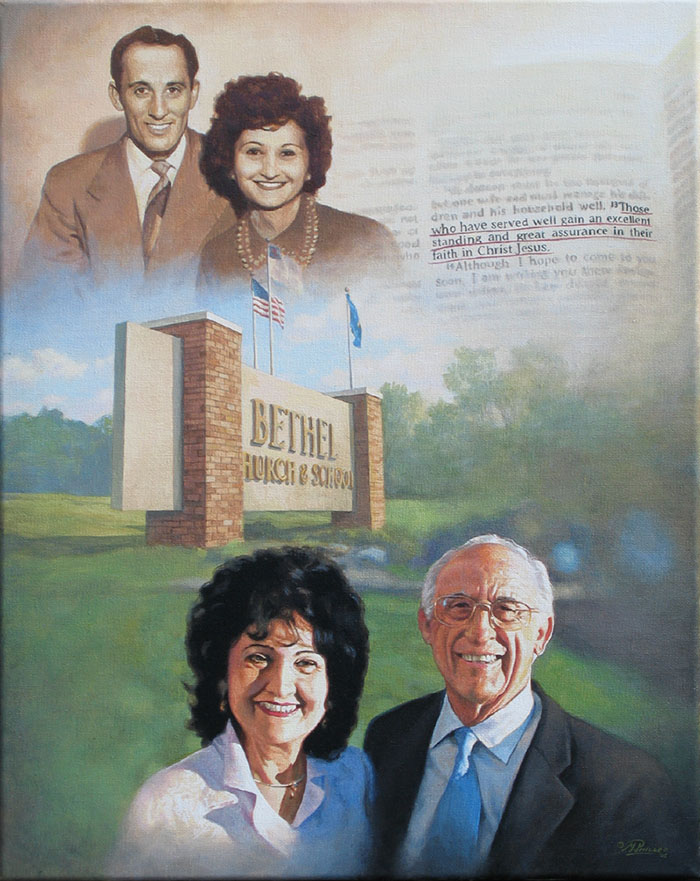
Portrait of Pastor & Mrs. Philip Palser, 16 x 20, acrylic on canvas, 2005 by fine artist Matt Philleo
I presented this to my pastor and his wife at his 80th birthday party. They loved it. That was 12 years ago, by the way. He is now 92, and still preaches (although not as much as he used to) today!
So again, I want to encourage you: if you are painting a portrait in acrylic, the next time you feel like giving up at a certain part in the process, push past it and keep going. Continually refer back to your reference photo, and paint exactly what you see. If you don’t give up, you will have the confidence knowing that you can finish what you started, and your paintings will never get the best of you. But you will give your paintings the best, and have something excellent to show for your efforts.
I’m writing this post on Good Friday, and this whole idea of finishing what you started, pushing past the difficulty, and seeing what good can come as a result, makes me think of Jesus’ passion. He could have decided as the going got tough–incredibly tough–knowing in advance what He would endure on the cross, to abandon his plan of providing salvation for the world by dying on the cross for our sins.
But instead, he headed for Jerusalem, knowing what would happen to Him there.
In the garden of Gethsemane, when it would have been easier to turn away from the preordained plan of experiencing God’s wrath for sin and even having His relationship with His father broken for a time, he prayed, “Not my will, but yours be done.”
And three days later, we all know…”the rest of the story.”
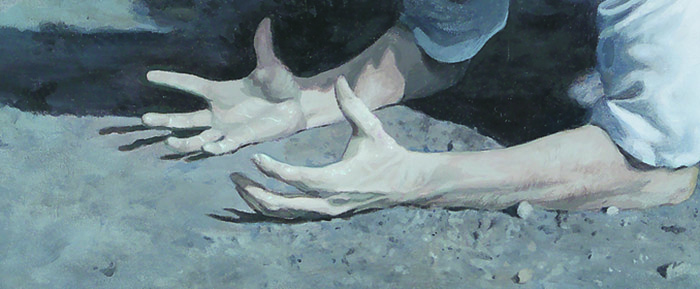
Portion of “Perfect Servant,” acrylic on canvas, 2002, by Matt Philleo
All this to say, there is great reward for not giving up, both in this life and the next. Happy Easter…and Happy painting!

–Matt
Share Your Thoughts!
If you have any comments or questions about what I wrote, please leave me your feedback below at the very bottom of the page! I will personally get back to you. Can you help me spread the word? Please share this post with your family and friends by using the social media links on the side or at the bottom of this page. Thank you!
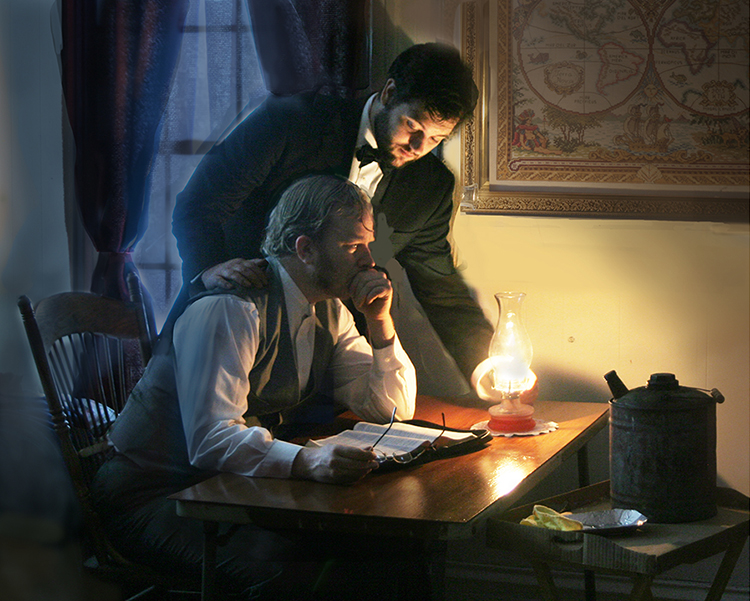
by Matt Philleo | Feb 22, 2017 | Encouraging Thoughts, My Art in Progress, New Artwork
In a previous post, I shared before how when I was going through a difficult time, God encouraged me with a verse in Isaiah 42 that inspired the painting “Smoldering Wick.” I sketched out the idea, and then the sketch sat around for a few years before I got the chance to actually paint it.
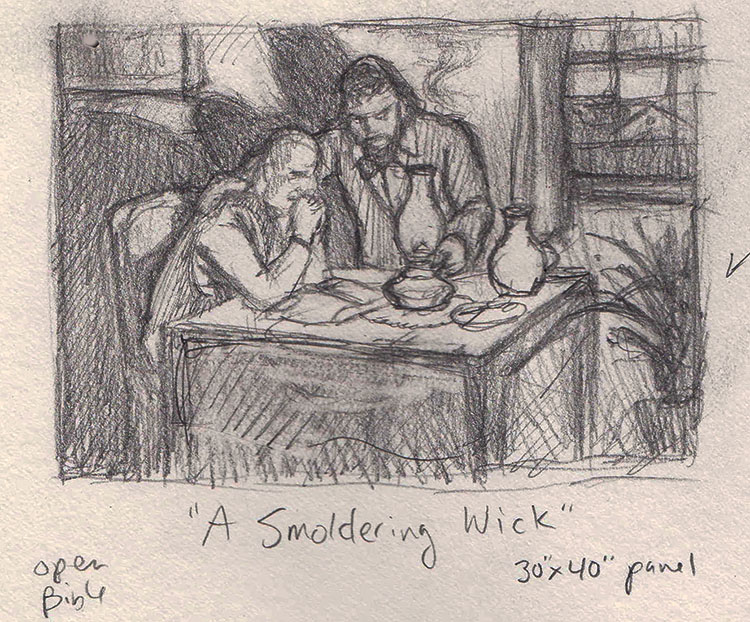
Original pencil sketch for “Smoldering Wick” by Matt Philleo
There were many distractions–a part time job, painting commissions, and my own procrastination. I wanted the painting to be just right. Waiting for the ideal circumstances, I delayed starting the project.
But finally, one day I realized unless I actually just took some steps to start the painting, it would never happen. So I asked my brother-in-law, Zach, to come over to my house for a photo shoot. Why a photo shoot? It’s not like I run a model agency! Here’s why…
When you are trying to do a realistic painting, you can’t just “invent” the realism.
At least I can’t. Maybe some can. But I think history bears out that the best realistic paintings of all time–like Rembrandt’s “Night Watch” or Caravaggio’s “Conversion of St. Paul” were painted using real-life models posed specifically for the artists to paint from.
In other words, they didn’t just paint from memory. They used a reference.
I am not comparing myself to either Rembrandt or Caravaggio, by the way. But their work inspires me.
One day then, Zach came over to my house, which I transformed into something like a theater stage or movie set. Well, one room at least. My wife gave me permission to do that for a few hours, as long as I put everything back in its place when I was done.
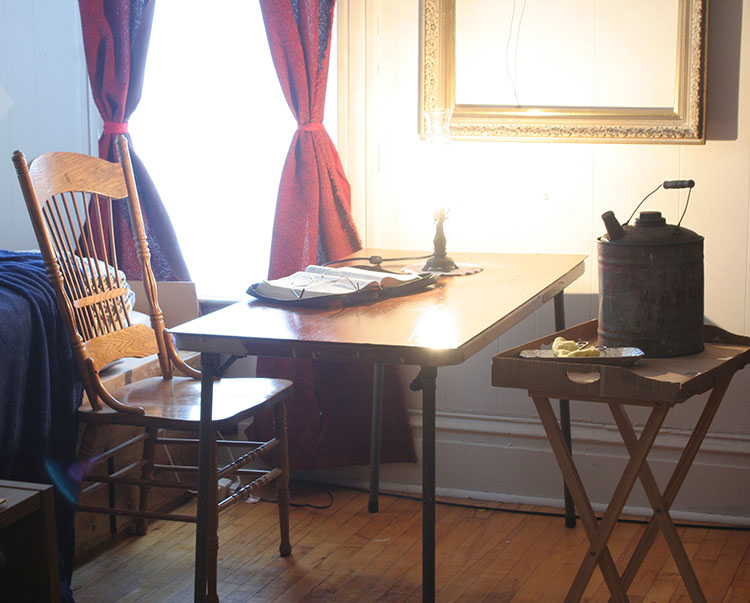
The “set” for “Smoldering Wick”
In the Victorian times, they had writing tables, simple and elegant. This is where the main character would be sitting. To recreate this look, I used a folded up plastic table and then made a fake top for it out of a piece of hardboard panel, which I painted to look like varnished woodgrain.
Then, I got my oil lamp ready, and made a fake doily (the knitted cloth things underneath that kept it from scuffing a table) for it out of paper.
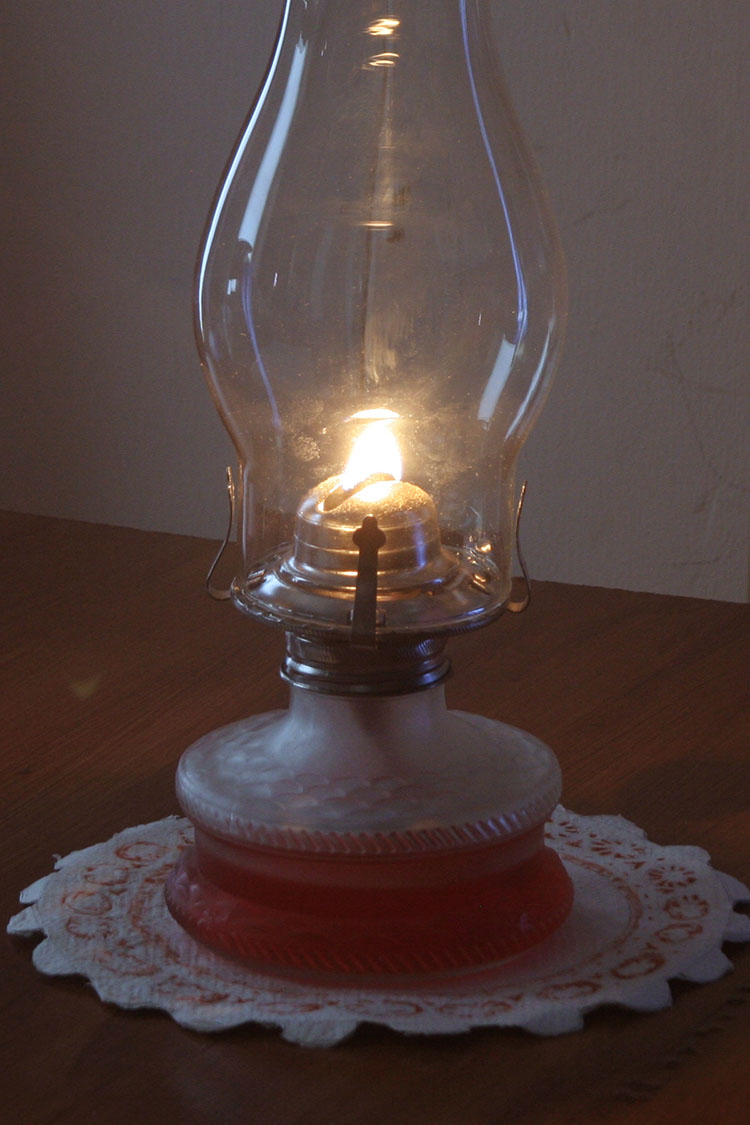
My trusty oil lamp with a homemade paper doily.
Interestingly enough, back during those kerosene-light days, the servant would come along and tend to the lamps in a house. He would bring a small foldable wooden tray on legs, carrying his supplies–a wick trimmer, a metal debris tray to hold the ash, a cloth to clean the chimney, and a can of kerosene. The servant would carefully trim off the burnt edges of the wick, raise it up higher, clean the soot off the chimney, and fill the lamp with fresh oil. The result would be a fresh flame that burns longer and brighter.
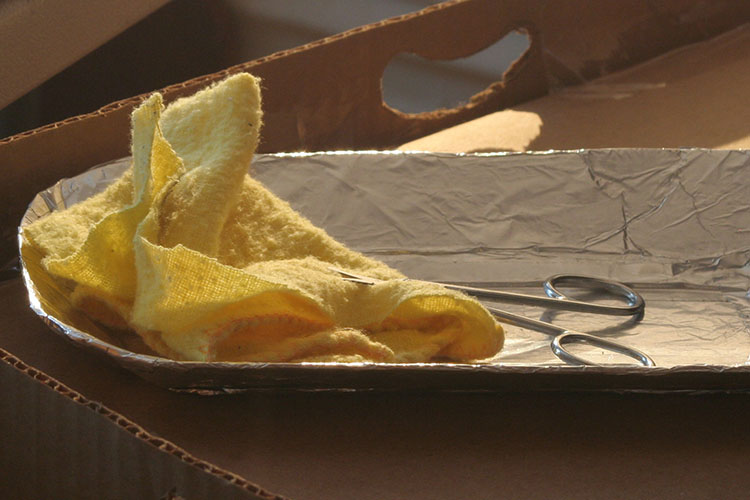
The wick trimming tray used by butlers in the 19th century
This symbolizes how God allows trials in our lives to “trim” the rough edges off of us.
Sometimes we hang onto to things that are worthless and keeping us from our full potential, from shining our light brightly. The wick trimmer is like the trial that cuts away the sins, the undesirable traits in us, and God employs this tool with precision, and masterful, loving care. His goal is not to hurt us, but to conform us to the image of Christ. And Jesus is the true Light of the World.
And to top it all off, Jesus said that when He would leave this earth, He would send the Comforter to us, that is, the Holy Spirit. In the Bible, the Spirit is often portrayed figuratively by oil.
For us today, the Holy Spirit is like that oil–an oil of gladness and joy– giving fuel to run on.
Without that joy, we will eventually burn out, even if we are busy doing great things.
Now, for the kerosene can, as a prop, I grabbed an old metal gasoline can from the shed.
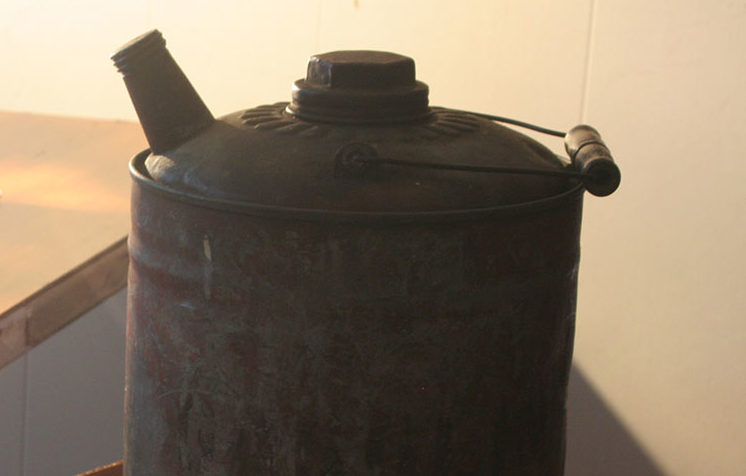
Old metal gasoline can used as a reference for a kerosene container.
I created this butler’s tray using a foldable TV-dinner tray covered with a cardboard box that mimics the sides of the antique tray. Of course, when I painted it in the painting, I made it look like wood rather than cardboard. But the cardboard structure was enough to paint by. The wick trimmer’s debris tray was cardboard covered with aluminum foil.
My brother in law had his tuxedo on, a perfect look for a victorian-era servant, and I had a dress shirt with a vest, and combed my hair in an old-fashioned style, and even shaved my beard to look like 1870’s style mutton-chop sideburns!
Next, we mounted my DSLR camera to a tripod and snapped a series of photos. In all, we probably shot about 200. It takes a lot of photos just to get a few that turn out. With a low aperature and slow shutter setting, we were able to capture the light from the lamp very well. As long as we didn’t move much.
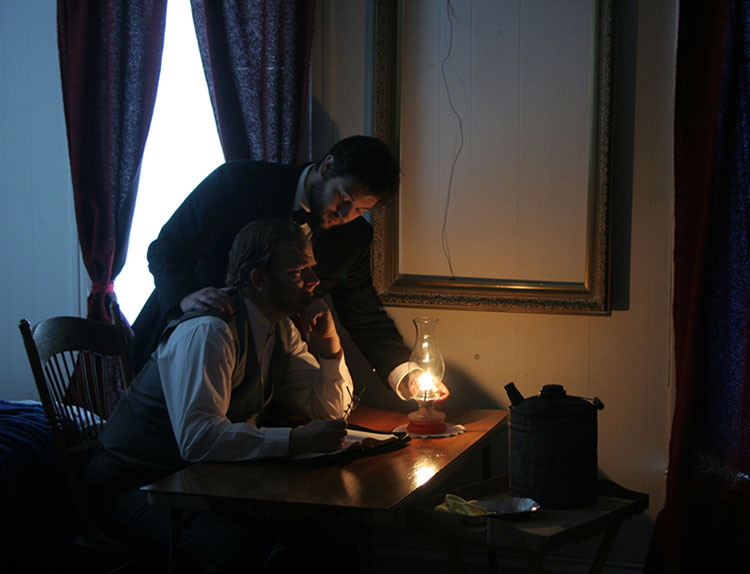
Zach Couture and Matt Philleo posing for the photo references used in the painting “Smoldering Wick,” 30 x 40, 2016, acrylic on canvas
I tried to think of the sadness of this man, and how I felt when I was discouraged.
As I played the part, some tears actually formed in my eyes, and I knew that was just the look I wanted in the painting to convey the despair, the loneliness, the longing of hope that he experienced just before the light of the truth dawned upon him.
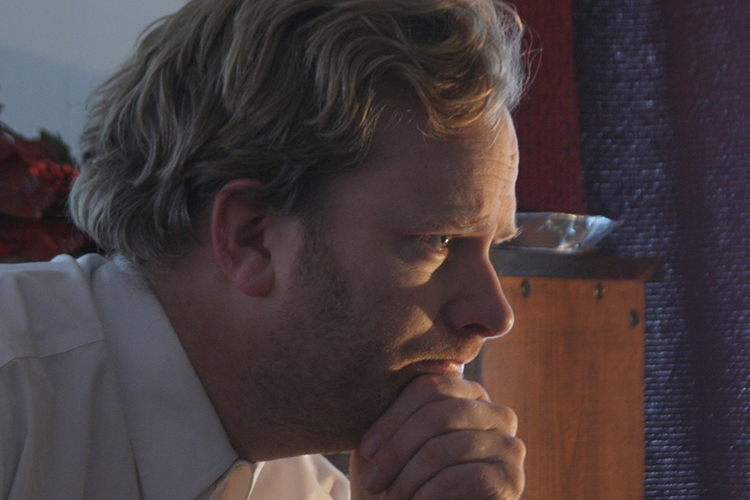
Matt Philleo posing for “Smoldering Wick”
Zach did a fantastic job in posing for the servant. He portrayed a genuine compassion in both his facial expression, and his body language. The servant was to symbolize Jesus Christ without actually looking like the typical long-haired Jesus that we are so familiar with in the Western World.
Jesus is the suffering servant.
He was tempted in all points like we are, yet without sin. He is acquainted with sorrows, and knew what it was like to have people reject Him, hate Him, and ultimately kill Him. And so He can sympathize with our weaknesses with true compassion and mercy.

Zach Couture posing in an interesting but unused photo reference for “Smoldering Wick”
We won’t discover the fullness of Jesus, though, just by looking at a picture of Him. Although that may help, the true picture of Jesus is formed in words–the Bible.
When we read about all that He did for us on the cross in taking our sins upon His shoulders and rising again to give us new life, it fills us with joy (if we receive it) and what was darkness and despair now turns to light and hope. I see my role as an artist to highlight, or draw attention to the truths already proclaimed in the Word of God. It allows me to speak and share with people that may never read a Bible or are turned off by institutional Christianity.
Zach and I spent the better part of the afternoon doing the photo shoot, and I ended up with some wonderful images to work from as references. The last step at this stage was to go through the images on my computer and select the best ones to use for the actual painting.

Main photo reference for “Smoldering Wick”
By the way, you may have seen already on Facebook, but I do have prints of “Smoldering Wick” available for sale now. If you would like to purchase a copy, I will sign it and put it in a distinguished black and gold mat, with a clear plastic sleeve. This is a special limited edition printed up locally by Eau Claire Printing Co.; I am only making 50 prints total. I would love for you to have one! Here is more information on how to order.
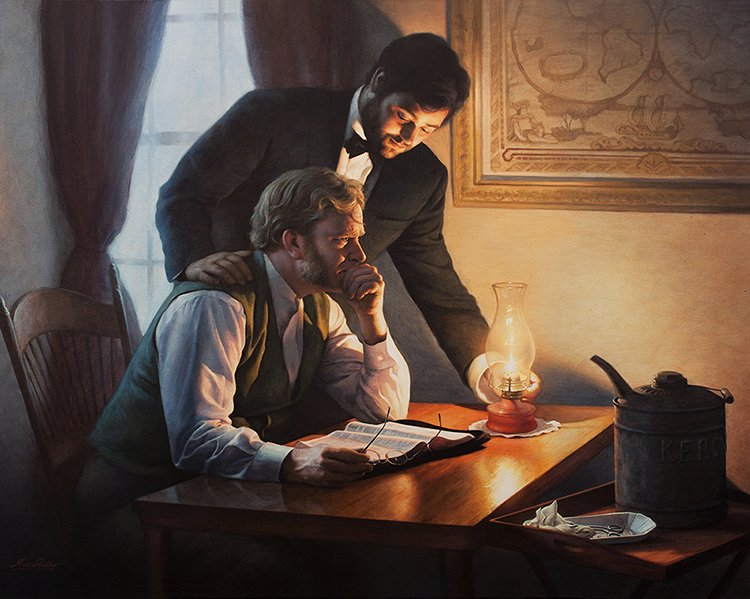
“Smoldering Wick,” 30 x 40, acrylic on canvas, 2016, by Matt Philleo

Signing a limited edition print of “Smoldering Wick”
In my next post, I will share more on the process of how I actually painted “Smoldering Wick…”
Share Your Thoughts!
If you have any comments or questions about what I wrote, please leave me your feedback below at the very bottom of the page! I will personally get back to you. Can you help me spread the word? Please share this post with your family and friends by using the social media links on the side or at the bottom of this page. Thank you!
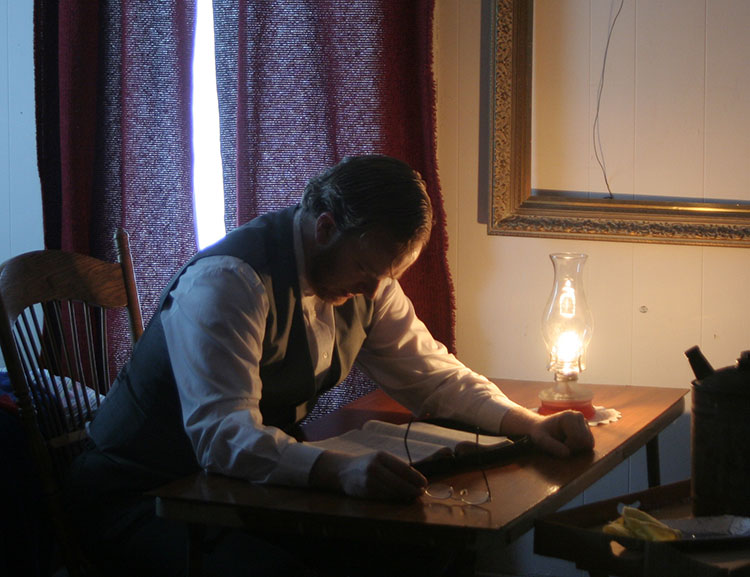
by Matt Philleo | Jan 18, 2017 | Christianity & Culture, Encouraging Thoughts, My Art in Progress, New Artwork, Personal Inspiring Stories
What do you do when you feel like you are at the end of your rope?
I recently finished a painting called “Smoldering Wick,” which I’ve shared on Facebook a little bit, and many people have asked what it is about.
Even though I just finished the painting just at the end of last year, the idea came to me several years ago. I was feeling discouraged about certain things in my life that weren’t measuring up, my failures and mistakes glaring me in the face, and I wondered if God could forgive me.
Many times when I feel this way, I get on my knees, open up my Bible in front of me and ask God to speak to me out of His word. Although I know God is forgiving and that He also will help me in all my discouragement and difficulties in life, I want to experience this forgiveness and goodness from God.
I want to know He is right there with me.
Some people may be able to, but I have a hard time shutting of the floodgate of my feelings. When I feel down, I can’t just put a smile on my face and pretend everything is OK when, inside, I feel like I’m drowning.
And I’ve found from experience that nobody knows me like God, not even myself.
And nobody cares to listen to me pour out the bitterness of my soul like God.
And nobody has the answers that I so desperately need like God.
And so this is what I do. I seek the Lord until He comes and reigns His righteousness on me. I know if I spend enough time there before Him, sooner or later, He will break through the hardness of my heart, or mind, and unbelief will melt away, and His light will cascade down upon me, breaking through the darkness.
And this all comes through His word, in the Bible.
So it was that one day, that I sought the Lord in my time of need, and I came across this promise in Isaiah 42:
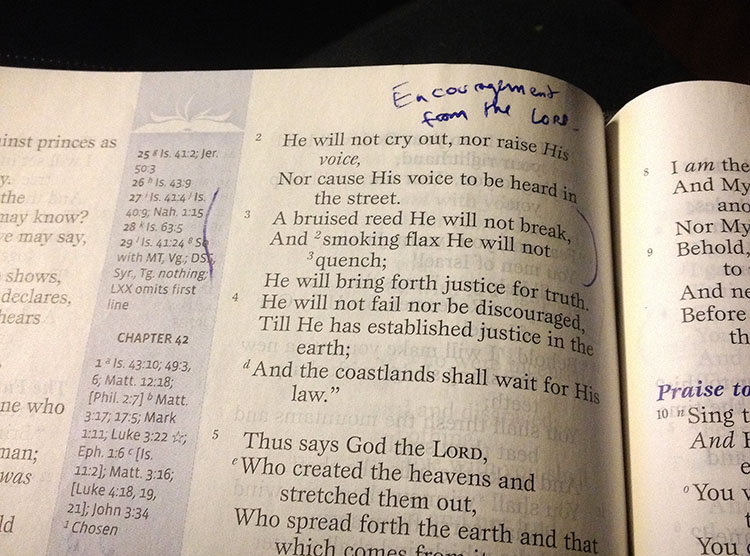
Isaiah 42:3 ” A bruised reed He will not break, and a smoldering wick He will not snuff out…”
In another translation it says, ” a bruised reed He will not break and a smoldering wick He will not snuff out…”
As I came across this verse, my heart was lifted up with joy. I felt the presence of God right there with me!
I knew that if I had even a flicker of a flame left burning for Him, He would not snuff it out.
In context, this verse, written by the prophet Isaiah around 700 B.C. was speaking prophetically of Jesus, who would be that suffering servant, God come in human flesh, the One would know what it was like to experience our pain, and could sympathize with us when were weak and beaten down.
And that’s exactly what I felt that day. It didn’t matter what I was going through, really. The trial that brought me up to this point, even if it was my fault. (Which it probably was) All that mattered was, God was in the house! God was in the room with me! And in experiencing that intimacy with Him: of His love, His faithfulness, His mercy, His gentleness, His kindness–I had everything I needed.
And so I wanted to commemorate this moment. Back in the Bible times, when God showed up, the ancient Israelites would put up a monument or a memorial stone to help them remember what God did for them. And so in the same way, I wanted to paint a picture to commemorate how God brought such encouragement to me! Also, I thought, “this may bring encouragement to someone else, if they get a glimpse of how kind, how patient God is with us.”
So I sketched it out. The title “Smoldering Wick” came right away. And then I thought, “I need to pick a time where they would use kerosene lamps to illuminate what they were trying to see,” so I picked the Victorian era.

Original pencil sketch for “Smoldering Wick” by Matt Philleo
The servant would symbolize Jesus, who shows compassion on us when we are discouraged.
I wanted the pose of the man to communicate that feeling, with his hand on his master’s shoulder. The man would be obviously distraught, but reading the Bible for comfort.
Because I wanted this to be a large painting with a ton of detail, it wouldn’t be started for another couple years after doing this sketch. I was still working part time at delivering newspapers and later working at a local recycling facility, and between that and commissioned artwork, I didn’t have a lot of time to work on one of my own paintings.
But I had the sketch, and the idea was recorded. When the time was right, the next step was to get together the photography for the painting, so that it would look realistic enough to convey the emotion and the concept to whoever looked at it.
Share Your Thoughts!
If you have any comments or questions about what I wrote, please leave me your feedback below at the very bottom of the page! I will personally get back to you. Can you help me spread the word? Please share this post with your family and friends by using the social media links on the side or at the bottom of this page. Thank you!
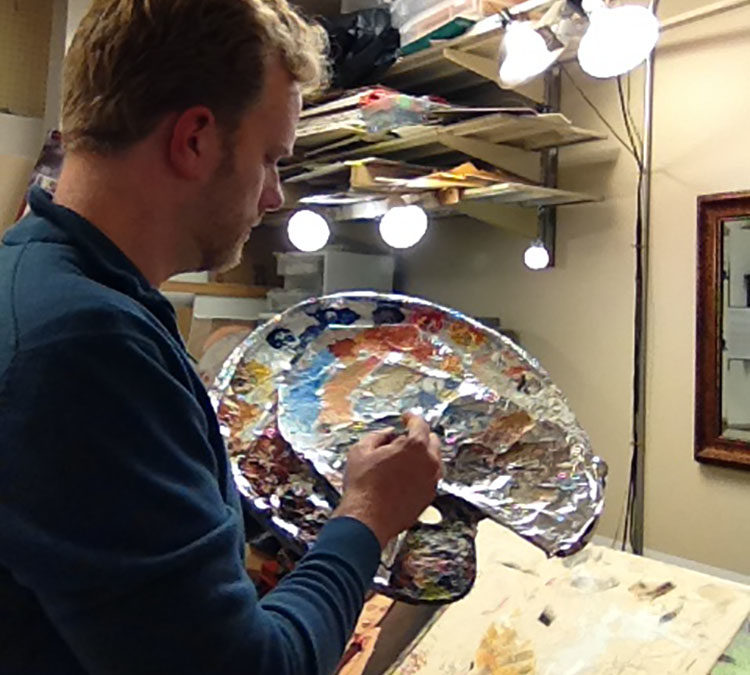
by Matt Philleo | Nov 25, 2016 | Art Shows, Encouraging Thoughts, How to Paint Instruction, My Art in Progress, New Artwork, Tips for Artists
Hope you had a great Thanksgiving. I know I did. It was rejuvenating to take a little time off from the studio, and spend it with family. Sometimes as an artist, you feel the crunch of having to create a lot of artwork, and your creative energies get tapped out. Thanksgiving’s a fantastic time to recharge, give thanks to God for all the blessings He’s given, be with family, and of course, eat a wonderful home-cooked meal.
Back to the studio tomorrow.
While teaching art classes lately, I’ve discovered one of the most challenging things for my students to learn is how to shade.
For artists and art appreciators, shading is a mysterious thing. We wonder how to do it, or how others did it.
Shading– the transition from a dark value to a lighter value in a two-dimensional work of art–is one of the most important techniques you can master to make a painting or drawing look realistic.
I’d like to share a video (hosted on YouTube) I created earlier this week about that, with you. This is my first art instructional video–in fact really the first serious video recording I’ve done, since the old days of playing around with a VHS-C camcorder with my buddies after school. We made some pretty crazy movies back then!
Somewhere towards the end of the video–maybe about 2/3 of the way through–is where I really get into it: how to do shading with acrylic and make it look real.
Hope you enjoy this video, and let me know if it helps you in your painting. Let me know, too, how I can improve it in any way, so going forward I can create some videos that are more helpful, or informative for you. Or maybe you don’t paint, but you are interested in the process of acrylic painting. Again, let me know if you’d like to see more stuff like this in the future!
And of course, as I always ask, please share this with your friends! Thanks!
Blessings,

Matt
P.S. I will have the painting featured in the video on display at the art show this Saturday at my studio. (1106 Mondovi Rd, in Eau Claire, 10-4pm)
Share Your Thoughts!
If you have any comments or questions about this post, please leave me your feedback at the very bottom of this page! I will personally get back to you. Can you help me spread the word? Please share this post with your family and friends by using the social media links on the side or below. Thank you!
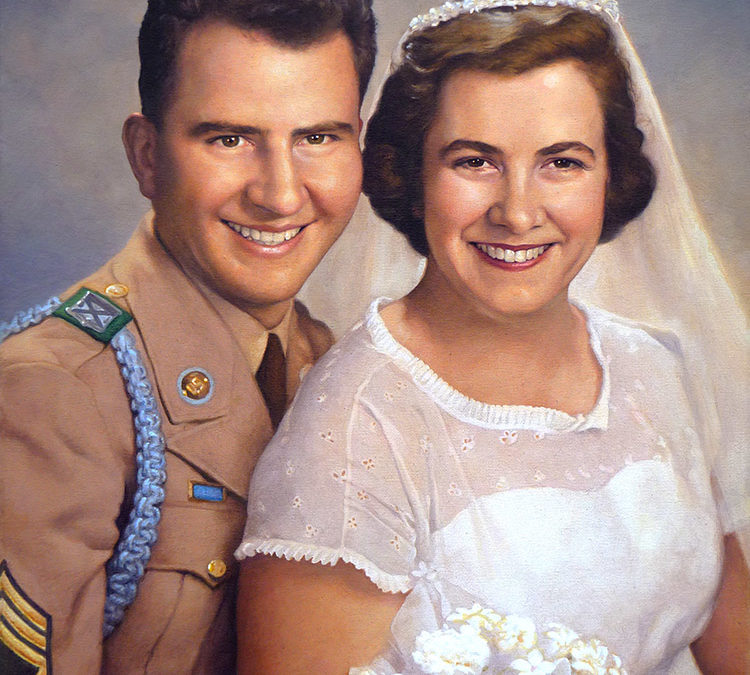
by Matt Philleo | Nov 11, 2016 | Encouraging Thoughts, My Art in Progress, Personal Inspiring Stories
It was November 11, 1919.
A year ago on that same day, Germany and the Central Powers agreed to put a stop to the war, laying down their arms and agreeing to the terms of peace set forth by the Allies. President Woodrow Wilson wrote a message to the people of America on this first commemorative Armistice Day:
“…The war showed us the strength of great nations acting together for high purposes, and the victory of arms foretells the enduring conquests which can be made in peace when nations act justly and in furtherance of the common interests of men. To us in America the reflections of Armistice Day will be filled with – solemn pride in the heroism of those who died in the country’s service, and with gratitude for the victory, both because of the thing from which it has freed us and because of the opportunity it has given America to show her sympathy with peace and justice in the councils of nations.”
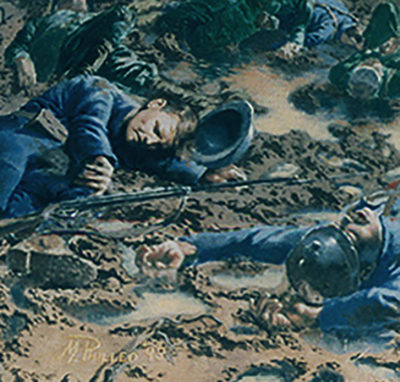
“Cafe on the Somme,” 24 x 30, Acrylic on Canvas, 1993, by artist Matt Philleo
Armistice Day was later officially changed to Veteran’s Day in 1954. This is a day that we honor veterans, not just those who have died in service, but the living as well.
Both my grandfather and grandmother served in World War II. My grandfather was a pilot who did bombing missions in the Philippines, and my grandmother was a troop transport pilot, spunky and zealous enough to get in the army at age 16 (beats trying to get in a bar under-aged, right?). They met there during service and later got married upon returning home at the conclusion of the war.
My brother in law is a veteran from the Iraq conflict, having served two tours of duty there. He sacrificed a lot of time to serve our country.
I know we say it so much that it seems cliche, but it’s true…
Our veterans served our country well and kept our freedoms secure–either by paying with their life, braving the ever-present threat of losing their life, or perhaps the worst: enduring the trauma of seeing their best friends dying in horrific ways.
We owe them a debt of gratitude.
A few years ago, I created a portrait for a friend from my church who served in the army. He lost his wife due several health problems, and I wanted to encourage him by giving him something to commemorate the memory of his wife.
This is the photo that he gave me to work from:

Photo of Gerald and Mavis J., on their wedding day
Since it was black and white I didn’t know what the colors were on his uniform. He offered to give the uniform to me, but I thought, “No, I better just take a picture of it instead. I sure don’t want to get paint on it!”
As for the colors of the flowers, I didn’t think he would remember after nearly 60 years, but I asked my mother-in-law. Without any trouble, she advised, “Oh yeah, those must be pinks, and those are carnations, and here’s the colors they would probably be.”
So with that information, I got to work.
Here are some in-progress pics of the painting. I start off with just a sketch, and then build up several translucent layers of acrylic paint using the Renaissance Master’s glazing technique.
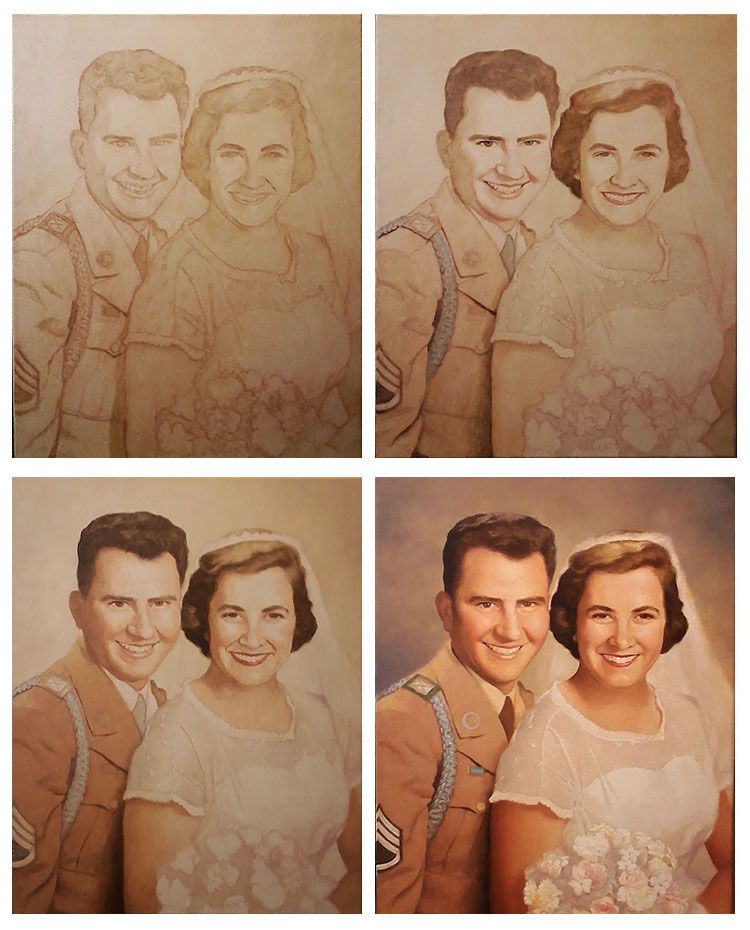
Portrait painting of Gerald and Mavis J, by artist Matt Philleo, in progress
A painting like this can easily take 30+ hours. But when considering the final goal of the project: encouraging a friend in his loss, every minute is worth it. After he received the painting, my friend wrote:
“Dear Matthew:
RE: Wedding Portrait–
Your loving kindness and genuine concern has deeply touched my heart, and will impact the hearts and minds of other for generations to come……….
God’s anointing on your work is a very special blessing–that reaches beyond the materials and talent–and moves with spiritual brushstrokes to paint love on the canvas of our hearts………….
E.M. Bonds says: God shapes the world by prayer. Prayers are deathless. They live outside the lives of those who utter them.’ Know that I am praying for you!
Like prayer–your work can be deathless, touching the lives of other for God’s plan through the strokes of eternity hidden in them…
Mavis always loved you–and I know she would be pleased and emotionally moved by your work.
Till she sees you again someday–thank you for your kindness and friendship and your Love.
“Shalom”,
Gerald
P.S. This small military remembrance is a token of our love.”
With that, he gave me some of his uniform accoutrements–buttons and his insignia. It was a blessing to be able to do that portrait for my friend and encouraging to get a letter like that. And here is the final 16 x 20 acrylic on canvas portrait.
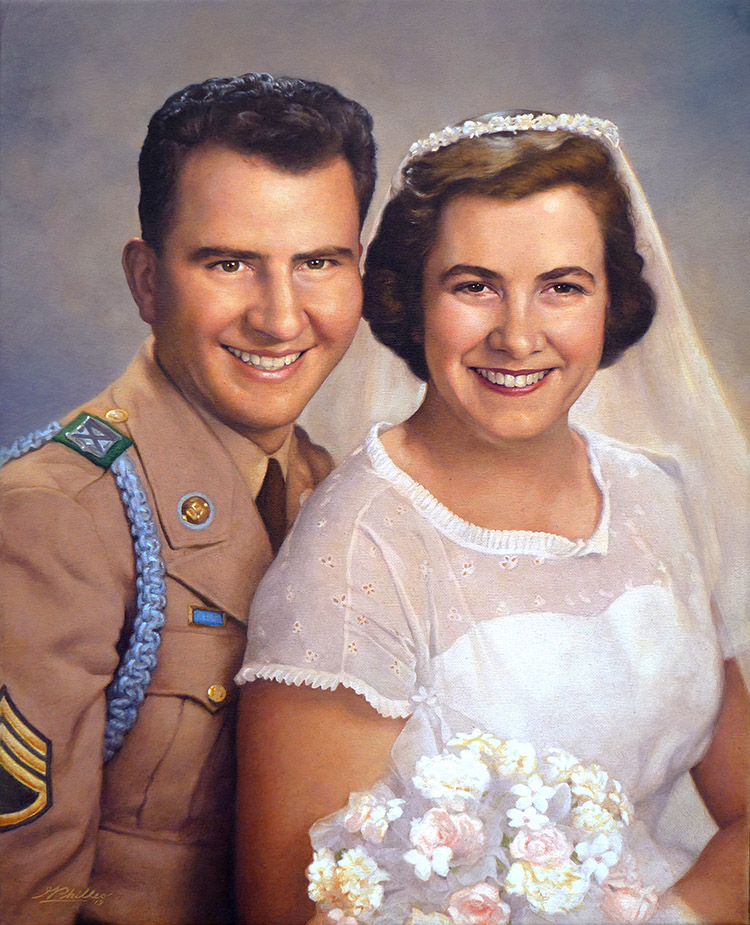
Wedding Portrait of Gerald and Mavis J., 16 x 20, Acrylic on Canvas, 2013, by Eau Claire fine artist Matt Philleo
I am hoping I can run into a veteran tomorrow. Many times you will see veterans in front of stores and at the post office on Veterans day. It’s more than worth it to spend a dollar on a “buddy poppy” and shake their hand and thank them for their service. Do you know a veteran who’s shut in? Pay them a visit. Just spending some time with them will encourage them and you may find yourself encouraged too as you listen to them share their stories.
Who are some veterans you know, and would you like to share any of their stories right now?
Share Your Thoughts!
If you have any comments or questions about this post, please leave me your feedback at the bottom of the page! I will personally get back to you. Can you help me spread the word? Please share this post with your family and friends by using the social media links on the side or below. Thank you!
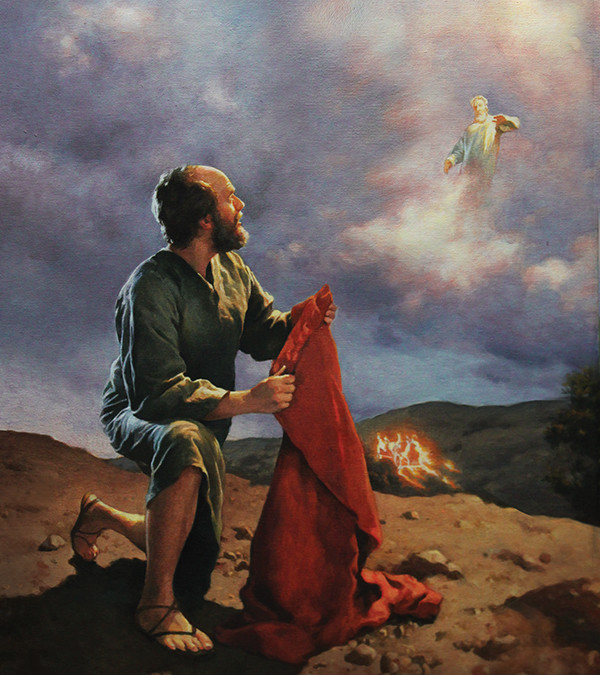
by Matt Philleo | Feb 4, 2016 | Encouraging Thoughts, My Art in Progress, New Artwork
Everybody has a calling; a unique reason for being here on planet earth.
It all starts with God as the foundation, since He created us, just like the engineer of a finely tuned watch knows what its purpose is.
And just like that watch will give honor to its maker by operating as it is supposed to, so will we, when we do what God has created us for.
In fact, the whole purpose of our lives is to bring glory to God.
The first and biggest way we can do that is accept the fact that we need Him and receive His forgiveness for our sins, His gift of eternal life to us through the accomplishment of His Son’s death and resurrection.
After that, step by step, we go on a journey to let the glory of God shine in our lives moment by moment, day by day, walking in dependence upon Him and bringing every blessing and every trial as a gift of thanks and a petition for help.
In the Bible, the prophet Elijah was about to be taken up to heaven. His special role as a messenger to God’s people would be transferred to His student and successor, Elisha.
These were big shoes to fill: Elijah had prayed for a drought to cause the nation of Israel to seek God again, and God shut up the heavens for three years. Elijah asked God to show His glory by fire on Mount Carmel so the Israelites would stop worshiping idols, and God sent the fire. And Elijah prayed again for it to rain, and sure enough, the parched, thirsty earth was given torrents of water to drink.
But as Elisha was seeing the amazing way the Lord provided for his teacher, he was being prepared to be used in the same way.
I met a wonderful gal at the Falling Leaves Art Studio Tour who connected me to another wonderful gal through this blog, who then connected me to a publisher in Abbotsford, WI. I was asked to paint an image of Elijah and Elisha for a book cover, and I thought it would be a great project.
It turns out the author of the book is a missionary that our church has supported for years! Here is the painting, titled “Picking up the Mantle.” It took about 25 hours to create. Below is a few in progress photos of the painting, leading up to the finished work ( I also have a video of the painting in progress as well):
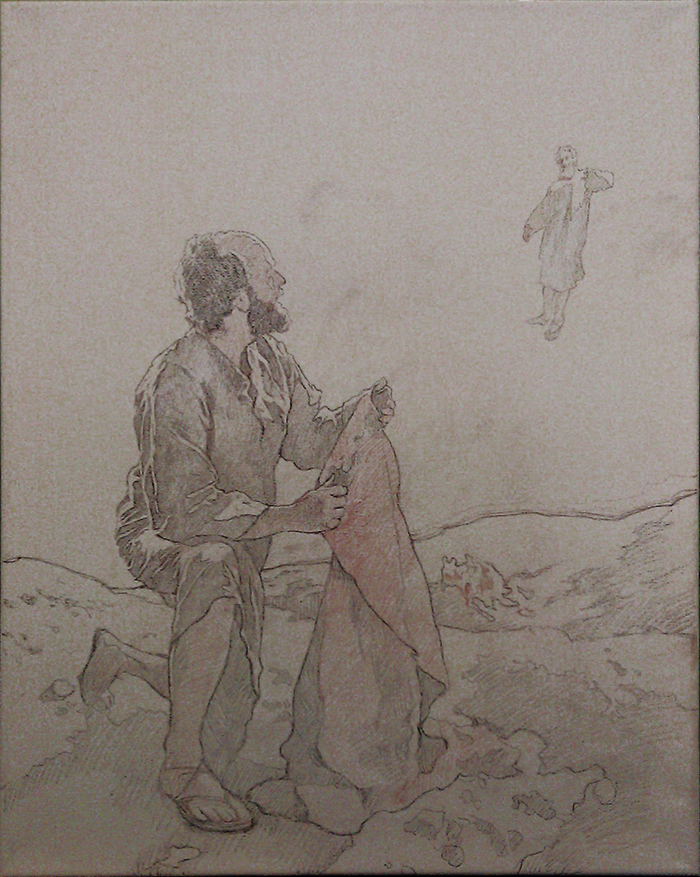
“Picking up the Mantle,” 16 x 20, Acrylic on Canvas, by artist Matt Philleo–sketch
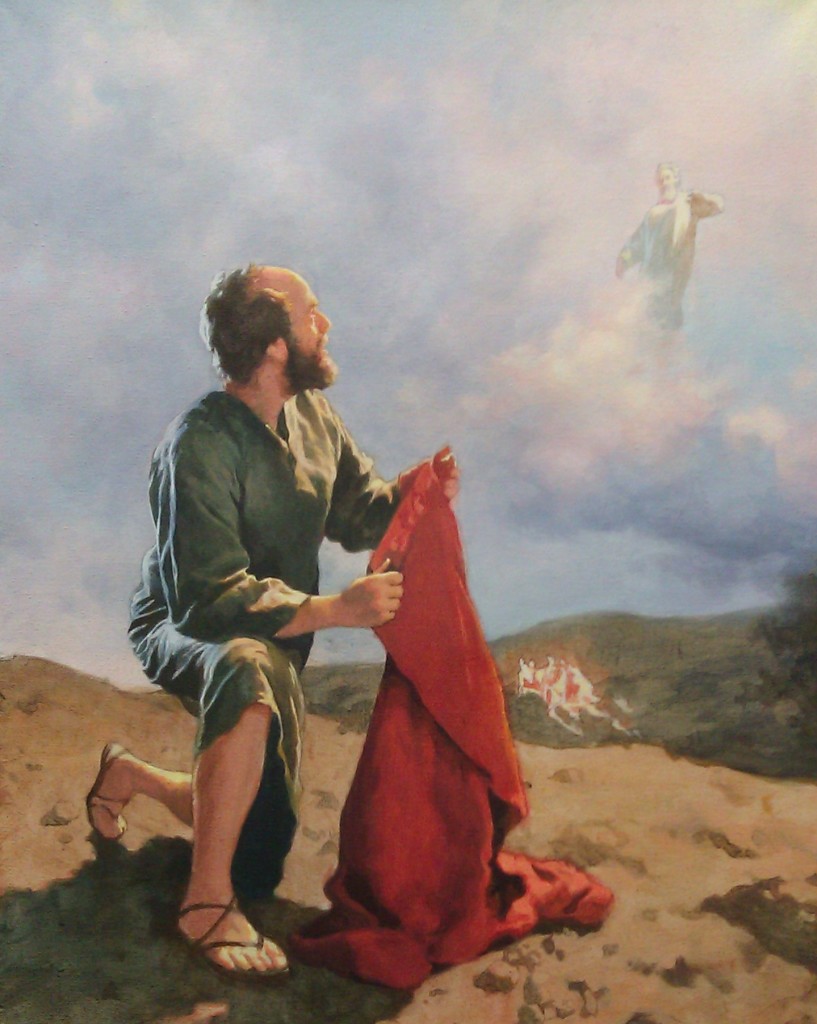
“Picking up the Mantle”
16 x 20, acrylic on canvas, by artist Matt Philleo–in progress

“Picking up the Mantle,” 16 x 20, Acrylic on Canvas, by artist Matt Philleo
In the painting, you see Elisha holding up Elijah’s cloak, or mantle, that he left behind for Elisha to pick up. The mantle represents Elijah’s special position as prophet, his unique calling, his anointing for service, and the power God had given him to carry out his duties. It was now for Elisha to carry on.
But you can almost see Elisha saying, “What now?” as his master is taken away. God had many adventures in store for him, but in this moment, he is simply awestruck.
The mantle is a symbol of what is being passed on to the next generation.
What are you–and me–passing on to our children and grandchildren?
I’d love if my kids achieve a certain level of success–all parents want that. But if they don’t have God–what good is it? My wife and I pray for my kids at bedtime, read the the Bible, and share the great things God has done for us. I want to do more of that. I want my kids to remember and think, “My dad sure had some issues, but one thing I know is that he really needed God and God came through for him. And God came through for me, too.”
What is your calling? Mine is to encourage. I don’t always do this well, but I know God has used me to encourage people and that is because He has encouraged me first. We love God because He has first loved us.
I finished this painting at the end of January, and then delivered it to the publisher after he decided to buy it in addition to purchasing the illustration rights of the image. That was a great blessing, because studio rent was due for the next month. God always brings in the provision just in time!
Share Your Thoughts!
If you have any comments or questions about this post, please leave me your feedback below! I will personally get back to you. Can you help me spread the word? Please share this post with your family and friends by using the social media links below. Thank you!
































Recent Comments